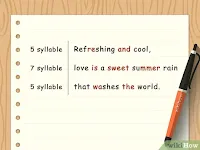The motifs that are mostly prevalent or predominant in haiku are time, nature and change. What Motifs are predominant in traditional haiku?
The motifs that are predominant in traditional haiku are used relatively to represent an idea.
What Is Motif?
A motif is a repeated pattern—an image, sound, word, or symbol that comes back again and again within a particular story.
When you spot a symbol, concept, or plot structure that repeatedly surfaces in the text, you're probably dealing with a motif. Also, they must be related to the central idea of the work, and they always end up reinforcing the author's overall message.
A descriptive example of motif is rose. Rose is generally regarded as love.
What Motifs Are Predominant In Traditional Haiku?
The motifs that are majorly predominant in traditional history are Time, Nature and Change.
For more proper explanation on the relation of motifs with traditional haiku:
A Traditional Haiku or Japanese Haiku is a form of poetry in which the poem is of just three lines. The first line contains 5 syllables, the second 7 syllables and the third and last line with again 5 syllables.
The motifs that are mostly prevalent or predominant in haiku are time, nature and change. They are written in the present tense without a rhyme, and alludes to these three components/ motifs.
Is A Motif A Type Of Theme?
A motif is not a type of theme. Contrary to the supposition, motif merely reinforces the theme of the story or poem. In such light, it can serve as a guide to identifying the theme of a haiku poem.
Thus, motifs can help the reader to discover, support or reinforce the theme, as well as evoking significant moments in the story in order to remind the readers of the connection between the scenes.
What Motif Is Used In The First Line Of The Haiku?
Motif is simply a recurring narrative element that has symbolic significance. This, if there's a symbol, idea, concept or plot structure that appears or surfaces repeatedly in the same work, then it's most likely a motif.
So, having a solid understanding of what Motif is—how do you identify what Motif is used in the first line of the haiku poem?
The first line of haiku is usually called the kigo. And the latter translates to words or phrase that serves as seasonal reference and helps to convey what time of the year or the season in which a haiku is set.
Thus, since traditional haiku are often written on nature or season, the motif used in the first line of the haiku poems is either time, nature or change.



%20(1).jpeg)

.png)
%20(3).jpeg)

COMMENTS